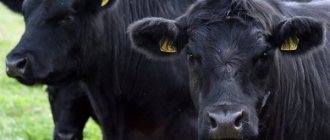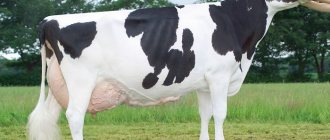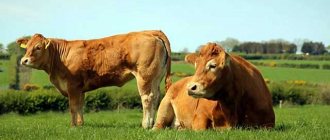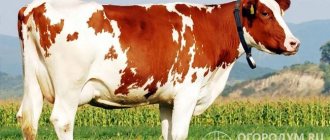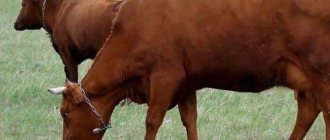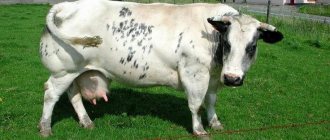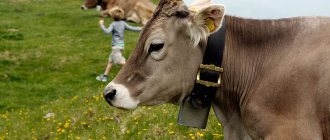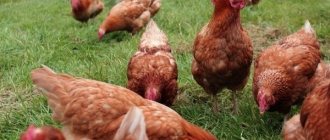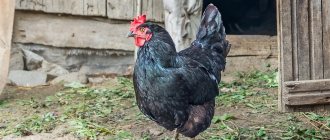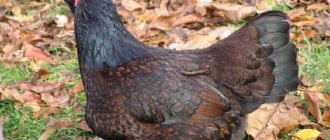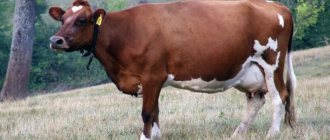The red steppe breed of cows is one of the most popular in Ukraine and the Russian Federation. The goal of the breeders was to develop a breed of cows that would be hardy, unpretentious and with an excellent physique. The breed is actively used in world animal husbandry; it can be found in Kyrgyzstan, Moldova, Kazakhstan and other countries.
Red steppe cow
Breeding history
It is believed that this is the first breed bred in Ukraine. Since the 18th century, they tried to improve Ukrainian cows with the help of the imported “Red Ostrfisslyandskaya” breed, later it was replaced by the “Wilstershskaya” breed, and even later by the “Angelskaya” breed. And already at the end of the 19th century, many dairy cows with uniform characteristics appeared on the territory of Ukraine. It was at that time that “Red Stepnaya” was registered. The breed that we know today has gone through a difficult journey and has undergone various changes. It was formed through selection in the process of crossing several breeds of cattle. In order to increase the endurance of cows and the level of milk yield, various genetic material was crossed, in particular, it combines the genes of the following breeds:
- Angelynskaya;
- Gray steppe;
- Ukrainian sulfur;
- Red Ostrfisslyandskaya;
- Simmentalskaya.
The red steppe breed is widespread in Ukraine and the southern regions of Russia. Moreover, selection work on it is still being carried out. Today, the Red Steppe is crossed with insemination bulls of various breeds due to the fact that it is a carrier of excellent genetic material, with which it is possible to improve such qualities of other breeds as:
- body type;
- udder shape;
- milk productivity.
Characteristic
Origin
The breeding of the breed goes back to the distant 18th century. But the first fruits of selection appeared in the 19th century. The breed was registered in 1923, and at that time breeding took place only on the territory of the USSR.
Since the breeds available on the territory were low-yielding, it was necessary to cross them with a breed that had high milk yield. Livestock breeders have different opinions about the origin of the breed and offer several crossing options:
- A mixture of Franconian and Swiss cattle;
- A mixture of Ukrainian cattle with the East Frisian breed, then re-crossing with the Angel and other foreign breeds;
- A cross between local breeds and imported red bulls.
Appearance
It is not for nothing that these animals are considered one of the best breeds in Russia, Kazakhstan, Belarus and Ukraine. They have a pretty good characteristic:
- At birth, bull calves weigh no more than 40 kg, while cow cows are born weighing no more than 30 kg;
- The weight of bulls reaches up to 900 kg, the weight of cows does not exceed 500 kg;
- They have a fairly strong build;
- They belong to the dairy type of productivity;
- The color of the coat is always red, the difference can only be in the tones. The spots can be either light red-brown or dark red;
- The neck is quite narrow and long, has many folds;
- Very often cows have a defect in the udder; it is uneven.
What does a red steppe cow look like?
Productivity
For the type of milk production, the cows are very good. The average milk yield is approximately 3000-4000 kg. But in breeding farms, cow cows give better results, because their milk yield ranges from 4000 to 5000 kg, with a fat content of 3.8-4%. There are also record-breaking cows that can produce up to 12,000 liters of milk, and the fat content of such milk reaches 5%.
The quality and quantity of milk production depend on pasture conditions and the length of the grazing season. Cows are quite fertile; just one cow can produce 3-4 offspring within 3 years.
The slaughter yield of cows does not exceed 50%. The indicator may increase if the animal is purposefully fattened.
Detailed description of the breed
Horned animals are easily recognized by the color of their fur - it is colored red or red-brown and differs in the intensity of its tone. Red-brown spots and white markings on the forehead, belly, udder and limbs are acceptable. In adult bulls of the breed, the upper and lower parts of the body are painted in a darker color.
These are quite large animals in build. The skeleton is light and thin, in tandem with underdeveloped muscles is a disadvantage; animals are susceptible to injury, dislocation of legs, walking on the uneven terrain of pastures.
Their body itself is somewhat angular and elongated. The belly is voluminous, which is typical for all representatives of dairy breeds, since their ribs are widely spaced. Unlike other breeds, in the red steppe representative it does not sag even during the period of bearing a calf.
The head is small, narrow, one might say graceful, the nose is dark-colored. The neck is long with many folds. The horns are light gray and point forward. This poses a threat to livestock and humans. During a fight, a cow or a bull can tear open the enemy and cause him serious injuries. Therefore, it is recommended to dehorn calves if possible.
The skin is smooth and elastic. If a cow loses weight, the skin will not sag. And weight loss and gain is a common occurrence for them, depending on weather conditions. The skeleton is quite light and fragile, the muscles are rather poorly developed.
The udder of cows is small, round, well developed, with cylindrical teats. It is convenient to milk cows by hand, as it is glandular, that is, soft to the touch. A fairly common sight is an irregularly shaped udder. When milk accumulates, the udder stretches greatly, so that after milking its volume decreases several times, and small folds form on the udder. The nipples are quite convenient for both manual and machine milking, the length of the front ones is about 6.5 cm, and the rear ones -5.7 cm.
External indicators
The Red Steppe is a fairly recognizable breed; its distinctive exterior features include:
- withers at a height of 125-132 cm;
- chest girth reaches 190 cm;
- oblique length can reach up to 160 cm;
- chest width according to measurements is from 37 to 42 cm.
- the body is angular and slightly elongated, the muscles are weak;
- the neck is narrow, tendonous with pronounced folds, the head is slightly elongated;
- the metacarpus in girth is 17-19 cm.
- the legs are strong and straight, the chest is narrow;
- the udder may be unevenly developed and of medium size.
Exterior Features
The following properties common to the breed are noted::
- uniform color from red-yellow to cherry-red (but there may be white marks on the udder, head, chest);
- muscles are weak;
- compact body with a length of 150 - 165 cm;
- light head;
- deep chest - up to 70 cm, medium in width - 45 - 47 cm;
- The topline is level;
- the udder is medium, cup- or bath-shaped;
- the stomach is voluminous, but not saggy;
- the shape and position of the limbs is correct.
Productivity
Milk production, considering that this is a dairy breed, is above average. But farmers note that milk yield is greatly influenced by the climatic conditions under which the animal lives. So, if a cow grazes on dense green meadows, it will produce up to 5 thousand liters of milk per year. In arid areas, milk yield will not exceed 4 thousand liters. It is possible to increase milk yield, but to a maximum of 10 thousand liters, if you provide the cow with high-quality food and good maintenance.
The record for milk yield for these representatives is 12 thousand liters during the lactation period.
Cow milk is healthy and has a high protein content (up to 3.6%), but a low fat content (up to 3.7%). However, some cows are capable of producing milk with a fat content of up to 5%, but this is the exception to the rule.
Description and characteristics of red steppe cattle
Bulls of the Red Steppe breed can grow up to 900 kg, and cows - up to 400-500. Newborn calves weigh up to 40 kg, heifers up to 30 kg. By the age of six months, young animals can reach 200 kg (subject to proper feeding). The color of the animal is reddish, but the intensity of the shade can be different - from fiery red to dark cherry. Just like the Krasnogorbatovskaya breed of cows. Some individuals are born with white spots (usually on the legs, head, udder). The main features of the direction are the oblong angular body.
Other characteristics of the breed:
- weak thin bones;
- straight strong legs;
- voluminous belly;
- deep narrow chest;
- insufficiently formed dewlap;
- thin long neck covered with folds;
- raised mane.
The breed's udder is small and round, but in many females it does not develop quite correctly, or the parts are simply uneven.
The productivity of heifers largely depends on the climatic conditions of rearing. For example, in the steppe regions, every year you can receive 3-4 thousand kg, or even increase this volume to 5 thousand kg, if you properly organize the care of livestock. Milk has a fat content of 3.8%. The red breed is an early ripening breed - it is inseminated at the age of 15-19 months. In terms of quantitative and qualitative productivity indicators, it is slightly inferior to the Bestuzhev breed. In Russia, red steppe cattle are the second most popular.
Is it possible to release the Red Steppe for slaughter?
Although the breed is considered a dairy breed and is used exclusively for producing milk, often among the red representatives there are individuals with the characteristic features of meat-dairy and meat breeds. So they also play a fairly large role in the meat industry, despite the fact that they are not distinguished by their impressive size and weight.
With normal feeding of bulls, the meat yield is no more than 50%. If you purposefully fatten them using an intensive feeding system, then the indicator becomes slightly higher, but not so much as to raise them exclusively for meat.
It is also believed that beef obtained from the Red Steppe breed does not have any special taste characteristics, although it is juicy and quite pleasant to the taste. Quality indicators directly depend on the method of feeding and the age of the animal.
Thus, the meat of cows kept on free grazing in the warm season, and in winter fed with hay, has higher taste characteristics.
Danish Red breed main characteristics
We can say that the red Danish breed of cows is a record holder in milk production. If the heifers are well looked after and fed properly, then one cow can produce up to 17,500 liters of milk per year.
The average milk yield is about 8000 liters per cow. Fat content of the product is 4.1-4.2%. This milk can be used to make cheese. It’s also nice that it contains a lot of protein – up to 3.5%.
The Danish Red breed belongs to the dairy and meat type of cattle, but they are not often raised specifically for slaughter. This is due to the fact that at a high rate of weight gain - up to 1.4 kg per day, the yield of pure products only slightly exceeds 50%.
Content
Although the breed is unpretentious and easily adapts to external climatic conditions, it is necessary to adhere to certain rules for its care.
Basic care
In winter, calves and adult animals are kept indoors without a leash, since they are less adapted to frost than to heat. It is not necessary to heat the barn, but for newborn calves the room temperature should be above +12 °C. Usually the cows themselves keep them warm and take care of everything they need. Animals are kept individually or in herds. If they keep a herd, then the inseminating bulls are isolated from the cows and calves.
Calves are raised in groups, in which young animals are grouped according to age:
- 6-9 months;
- 1-1.5 years;
- 1.5-2 years.
In the calf room, the floor is made of sawdust and straw; it should be deep and permanent. Provide them with room to move, they should be able to move actively in the fresh air and in the pen.
In the warm season, the herd is allowed to graze freely on a pasture, which should be located 2 km from the farm. The place must first be provided with a watering hole so that the animals do not suffer from thirst.
Main care businesses:
- regular vaccination of livestock;
- preventive examinations;
- maintaining hygiene - cows are regularly combed, udders washed before milking, and massaged;
- Hooves and horns are trimmed before free grazing begins.
Dead period
Each cow must be given a “dry” rest when she is not milked. The period lasts from 40 to 70 days. Its duration depends on the health of the cow and its nutritional status. Weak, thin animals need longer dry periods - a maximum of 70 days.
For a well-fed cow with average productivity, 40-60 days are enough. The rest from milking cannot be shortened. If a cow is constantly milked from calving to calving, this will negatively affect her reproductive function, health, and quality of milk.
Breeding
Red cows are fertile - on average there are the same number of calves per 100 females. Heifers are born for the first time (on average) at one and a half years old.
The selection of an inseminating bull is approached with great attention; it should not have hereditary defects in the body structure. If a cow has exterior defects, then a bull without genetic defects must be selected as a mate. This will reduce the risk of poor-quality calves being born.
If a cow has udder developmental defects, then it is not used for breeding livestock.
Nutrition
Although animals are unpretentious to food, to increase milk yield, they must be fed with high-quality feed.
In the summer, lush, fresh vegetation is enough for them; in the winter, the cattle are fed hay with the addition of mixed feed. It’s also good to add root vegetables, silage and concentrated ingredients to the menu.
You cannot feed animals:
- low-quality products - rotten, rotten, spoiled;
- cold, including drinking cold water.
Food for calves must also be of high quality, otherwise they may develop croup defects and incorrect leg positioning.
Diseases
Red cows have high immunity; they rarely suffer from leukemia and respiratory diseases. They must be vaccinated against foot and mouth disease, anthrax and emphysematous carbuncle (emkara).
Prevention against parasites that settle in the digestive system or lungs is carried out annually. In the summer, animals are checked for the presence of ticks and gadfly larvae, which develop inside the skin, and bites are treated.
Another disease of females of the breed is mastitis, which develops during machine milking. To avoid this, you should gently massage the udder after each milking.
Possible diseases
Blue cows have strong immunity. The breed is resistant to leukemia. Not a single case of illness with a dangerous disease has been registered. Animals are also distinguished by the absence of genetically fixed mastitis.
The main problems arise from poor care:
- Keeping in pens with poor ventilation.
- Dirt and irregular cleaning.
- Bedding that is rarely changed becomes a breeding ground for pathogenic bacteria.
- Unbalanced feeding.
Epidemics are also dangerous for blue cows. Timely vaccination will protect against rabies, foot and mouth disease, anthrax and other deadly diseases.
Summer heat is favorable for the development of pathogenic microorganisms. Sanitizing the barn will prevent problems. To maintain the health of animals, it is advised to observe hygiene measures and monitor the condition of the cows. If behavior is uncharacteristic, call a veterinarian. Isolating sick individuals will stop the spread of infection among the rest of the population. The Latvian blue cow is a rare species that has a hundred-year history of development. Now the conservation of blue animals depends on the efforts of enthusiasts and the support of the authorities.
What do you need to know about caring for a newborn Red Steppe calf?
The newborn calf is immediately placed in a special cage. The temperature in it should not be lower than +12 degrees, it is important that there are no drafts, and that there is a thick layer of straw on the floor. Calves are fed maternal colostrum 4-5 times a day, serving 0.5-1 liters per meal, which can be increased to 2 liters as they grow. Feeding is carried out through a special nipple, the hole in which is designed specifically for newborn calves.
A calf 2 days old can already be given warm water (2-3 liters per day).
The first weeks of life are the most important for calves, so care must be especially careful. Manure should be thrown out several times a day, and all containers for drinking and feeding should be doused with boiling water. Upon reaching 10 days of age, solid food can be introduced into the diet, as an option - brewed hay.
How did the cows turn out?
It was easy for the red steppe cows to get used to life in new conditions, they showed their unpretentiousness in nutrition and maintenance, were resistant to various types of diseases, but most importantly, they showed a high average annual milk yield, as a result of which, quite expectedly, this breed became very popular among livestock breeders and widely spread not only in Ukraine, but also in many other countries of the world with a similar climate.
Time passed, living conditions and the political situation changed. In 1923, this type of home companion for the rural man in the street was officially registered in the Soviet Union. Today, the described variety is one of the most popular species in our country. It is most numerous in the territory of Zaporozhye and in adjacent regions of the state. Her milk pleases children and adults from different parts of the country.
In modern conditions, this breed has undergone some changes and, unlike its first representatives, is not only dairy, but also has a powerful muscular body, which is especially valued by our compatriots.
Advantages and disadvantages of the breed
When choosing a breed, you should not rely only on milk characteristics. It is not for nothing that the red steppe breed is popular in private farms. It has many more pros than cons.
Advantages
Among the advantages, experts note:
- High adaptive qualities, animals easily adapt to different climatic conditions. It is best to breed them in southern regions with a hot climate. Under the scorching rays of the sun, they not only feel great, but also do not lose, but, on the contrary, gain weight on meager feed. But you still need to take care of the animals. They will be grateful to the owner if he makes canopies, in the shade of which they could hide and rest from the heat.
- They are characterized by environmental endurance. Animals are not afraid of cold wind or rain; they endure the summer heat, when the thermometer exceeds +30 °C. Animals can also graze in the sun without water.
- They reproduce well, quickly increasing their numbers.
- All individuals, regardless of age, have high immunity to various diseases, including leukemia.
- Animals are unpretentious in food and maintenance.
Flaws
However, along with significant advantages, some disadvantages can be identified:
- A significant disadvantage of cows is the irregular shape and uneven shares of the udder. As a result of machine milking, milk does not completely come out of the nipples, which provokes the development of mastitis. To reduce the risk of developing the disease after milking, be sure to do a daily massage, which also helps to increase milk output.
- And the second drawback was described above, this is poorly developed muscles of the lower extremities. Therefore, hilly places for grazing should not be selected for red steppe cows; the legs of representatives of this breed are absolutely not adapted to wandering over uneven pastures.
What are the origins of the breed
The roots of the appearance of the red steppe breed go back to the end of the 18th century. In those distant times, Ukrainian lands were part of the Russian Empire, which was actively expanding its borders. One of its new acquisitions was the Tavria Peninsula, known to us today as Crimea. It was there, in the area of the Molochnaya River, which flowed through the territory of the Tauride province, that the heroes of this review appeared. The fauna of this territory was not very diverse in the village, so the residents began to breed red-steppe cows.
Due to the rapidly changing political situation in the empire, many peasants began to change their place of residence. The peasants of Tavria were no exception. And it is quite natural that during the resettlement to another place, the new red steppe cow also wandered along with the villagers. Thus, new individuals appeared on the territory of the Volga region and Donbass, Kherson and Yekaterinoslav.
Here breeding was carried out at the discretion of the owners: either within the species, or through further crossing with local breeds. The homeland of the steppe cow has a hot climate, so it is not particularly widespread in other regions of the Russian Empire. Residents of other regions mostly bred offspring of this group or other types of cattle.
What do you need to know when purchasing representatives of the Red Steppe breed?
If you intend to purchase a calf of this breed, then you should pay attention first of all to its weight, which should be fully consistent with its age. So, a newborn bull should weigh from 35 to 40 kg, and a heifer from 25 to 30. But already a six-month-old bull reaches a weight of 120-140 kg, and a heifer - 80-90.
Not the last place when choosing a cow is occupied by the growing conditions, as well as the availability of a full set of veterinary documents (animal passport, vaccination certificate, data on diseases, if any). Before buying, you should carefully examine the animal; its behavior alone speaks volumes - it must be well-groomed and playful. If purulent discharge is noticeable from the eyes and nose, then it is better to abandon such an individual.
When purchasing an adult, you need to pay attention to the udder, its shape, appearance and condition.
Purchasing young animals of this breed and adults will cost 50,000-80,000 depending on the region.
How to choose a dairy cow
When choosing an animal, you need to pay attention to appearance (exterior), age, as well as some other physiological indicators. Cows with high milk yields have the following characteristics:. Cows with high milk yields have the following characteristics:
Cows with high milk yields have the following characteristics:
- the head is small, elongated;
- the neck is thin and folded, with a slight dewlap;
- the withers are straight, high, not very wide;
- the back is level, the transition of the lower back to the croup is without depressions;
- the belly should not be too tight or very saggy;
- limbs must be strong;
- the coat is smooth and shiny, and the skin is dense (with a small amount of subcutaneous fat), thin and flexible.
Particular attention should be paid to the udder:
- thin skin with sparse hairs;
- well-developed venous network;
- a wide milk well (abdominal depression) into which the milk vein flows: it can be felt with fingers on both sides of the body (the wider the ring, the higher the milk yield);
- The udder lobes are identical, the teats are conical or cylindrical, 6–8 cm long.
Find out what udder diseases cows have.
To avoid purchasing a very old cow, you need to pay attention to:
- teeth that grow in cattle at certain periods, so the presence of a specific tooth indicates the exact age of the animal (after the appearance of all teeth, the age is determined by the degree of their abrasion and wear);
- horn rings that appear after each calving: in heifers, age is determined by the length of the horns; in 1 month they extend by 1 cm.
There are also some folk signs indicating the high productivity of cows:
- the deeper the depressions between a cow's horns, the more milk she gives;
- a low-hanging forelock on the head is also a sign of high milk yield;
- the rounded tip of the tail is yellowish in color - evidence of good fat content of the milk;
- pits below the shoulder blades are evidence of good productivity.
Important! Peak milk production occurs after 5–6 calvings. Dairy cows are also distinguished by their calm nature. In order to have enough dairy products, you must not only choose a dairy cow, but also take into account all the recommendations listed above
In addition, to obtain high-quality milk, animals need a balanced and varied diet, as well as good living conditions.
In order to have enough dairy products, you must not only choose a dairy cow, but also take into account all the recommendations listed above. In addition, to obtain high-quality milk, animals need a balanced and varied diet, as well as good living conditions.
Dairy cows are also distinguished by their calm nature. In order to have enough dairy products, you must not only choose a dairy cow, but also take into account all the recommendations listed above. In addition, to obtain high-quality milk, animals need a balanced and varied diet, as well as good living conditions.
Farmer reviews
In Russia, red steppe cows are in second place in terms of population. Breeders also continue to work with these representatives. Since cows give good milk yield even on meager feed, they can be bred in areas suffering from drought. Animals are unpretentious to feed, easily adapt to different climatic conditions, have high immunity, and therefore are suitable for keeping in farmsteads.
We bring to your attention several reviews from real farmers about the Red Steppe breed:
★★★★★
Vitaly, 53 years old, cattle breeder from Crimea. “In Crimea, we always had red steppe cows in our farmsteads.
They are the only ones who help us out in times of drought, when the steppe turns into a yellow-gray space. Along the shores of man-made lakes, even the grass dries up. Only sheep and our red cows find food at this time. There is nothing to complain about, the milk yield is good, they are unpretentious, care is the same as for other cattle. There are no problems with them in breeding; the calves are born healthy and strong.” ★★★★★
Vladimir, 45 years old, farmer from Gomel region. “I have only this breed on my farm; I specially selected it for our steppes.
Every summer I drive them out into the steppe. The neighbors’ horses are becoming thin and scary to look at, but mine are only gaining weight. True, I feed the calves with grain so that they become thicker by the fall. But in general, there are no problems, I’m happy with the breed.” ★★★★★
Pavel, 60 years old, Belgorod region. “Red cows really don’t require a lot of care and don’t have any special preferences when it comes to food.
Their immunity is good, although my little cow recently got sick with mastitis. And the milk is tasty, the sour cream and cottage cheese are good. I recommend this breed to everyone who breeds cows; there are practically no problems with it.” Hide
Add your review
So, the red steppe breed of cows gives good milk yield even on meager feed in the steppe regions; they can be bred in arid regions. And due to its unpretentiousness to feed, as well as resistance to climatic conditions, the breed is excellent for keeping in private farmsteads.
0
0
Copy link
Origin and distribution
The red steppe breed of cows was first bred three centuries ago in Ukraine.
It appeared due to the crossing of a western individual with a gray steppe, intended for draft work and sled work. The Chumaks used the cattle to travel to the Crimea for salt. But over time, animals lost their necessity due to their slowness and ceased to be used for their intended purpose. German colonists began to crossbreed cattle with foreign dairy animals - red East Friesian, Simmental and others. The choice was not accidental, since these breeds have similar genetics, similar metabolism, are milk-oriented and are intended for milking machines. As a result, the red steppe breed was developed. It got its name thanks to the color and the natural area in which it was created.
A little later, the variety was officially recognized, and gradually it began to appear in Russia - in the Volga region, Stavropol Territory, Western Siberia, Kuban and other regions.
Today, these cows are bred in the Caucasus, Kazakhstan, Moldova, and also in the Russian Federation. In Russia it is most widespread: its population is about 13 million animals.
A distinctive feature is the mass is proportional to milk yield
Breeders have been breeding the Red Danish breed for hundreds of years. During this time, they noted the following features inherent in these animals:
- high fertility and high survival rate of offspring;
- a Danish calf is almost never stillborn;
- calving in cows occurs easily and without consequences;
- high life expectancy;
- maintain high productivity throughout their entire life span;
- good immunity, the main feature of which is the cows’ resistance to mastitis and tuberculosis;
- high degree of adaptability.
Of course, the main property of red Danish cows is regular and high milk yield, which increases in direct proportion to weight gain.
Diseases and prevention
A significant advantage that attracts farmers is the high immunity of this cattle. There is a high resistance to leukemia, as well as a low risk of infection and progression to cancer. Preventive measures include routine examinations, blood tests and vaccinations.
Problems often arise with imperfect body design. Thus, red steppe cows on uneven pastures injure their legs when jumping unsuccessfully due to muscle weakness. The narrow structure of the croup and its droopiness can create difficulties during pregnancy and birth of large calves. But such problems are difficult to predict, so they cannot always be avoided.
